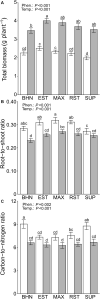Tomato Rootstocks Mediate Plant-Water Relations and Leaf Nutrient Profiles of a Common Scion Under Suboptimal Soil Temperatures
- PMID: 33552111
- PMCID: PMC7859091
- DOI: 10.3389/fpls.2020.618488
Tomato Rootstocks Mediate Plant-Water Relations and Leaf Nutrient Profiles of a Common Scion Under Suboptimal Soil Temperatures
Abstract
Environments with short growing seasons and variable climates can have soil temperatures that are suboptimal for chilling-sensitive crops. These conditions can adversely affect root growth and physiological performance thus impairing water and nutrient uptake. Four greenhouse trials and a field study were conducted to investigate if rootstocks can enhance tomato performance under suboptimal soil temperatures (SST). In a controlled greenhouse environment, we exposed four commercial rootstocks (Estamino, Maxifort, RST-04-106-T, and Supernatural) grafted with a common scion (cv. BHN-589) to optimal (mean: 24°C) and SST (mean: 13.5°C) and compared their performance with the non-grafted BHN-589 cultivar. Several root and shoot physiological traits were evaluated: root hydraulic conductivity and conductance, root anatomy, leaf gas exchange, leaf δ13C, shoot C and N, and biomass. Under field conditions, the same five phenotypes were evaluated for canopy growth, normalized difference vegetation index (NDVI), leaf nutrients, biomass, and yield. Under SST, root hydraulic conductivity (Lp) and conductance (K R), stomatal conductance (g s), and plant biomass decreased. Hydrostatic Lp decreased more than osmotic Lp (Lp ∗ hyd: 39-65%; Lp ∗ os: 14-40%) and some of the reduced conductivity was explained by the increased cortex area of primary roots observed under SST (67-140%). Under optimal soil temperatures, all rootstocks conferred higher g s than the non-grafted cultivar, but only two rootstocks maintained higher g s under SST. All phenotypes showed greater reductions in shoot biomass than root biomass resulting in greater (∼20%) root-to-shoot ratios. In the field, most grafted phenotypes increased early canopy cover, NDVI, shoot biomass, and fruit yield. Greenhouse results showed that Lp ∗ os may be less affected by SST than Lp ∗ hyd and that reductions in Lp may be offset by enhanced root-to-shoot ratios. We show that some commercial rootstocks possess traits that maintained better rates of stomatal conductance and shoot N content, which can contribute toward better plant establishment and improved performance under SST.
Keywords: Solanum lycopresicum L; grafting; mineral nutrition; root anatomy; root hydraulic conductivity; stomatal conductance.
Copyright © 2021 Bristow, Hernandez-Espinoza, Bonarota and Barrios-Masias.
Conflict of interest statement
The authors declare that the research was conducted in the absence of any commercial or financial relationships that could be construed as a potential conflict of interest.
Figures







Similar articles
-
A systematic assessment of how rootstock growth characteristics impact grafted tomato plant biomass, resource partitioning, yield, and fruit mineral composition.Front Plant Sci. 2022 Dec 15;13:948656. doi: 10.3389/fpls.2022.948656. eCollection 2022. Front Plant Sci. 2022. PMID: 36589098 Free PMC article.
-
The relationship between root hydraulics and scion vigour across Vitis rootstocks: what role do root aquaporins play?J Exp Bot. 2012 Nov;63(18):6445-55. doi: 10.1093/jxb/ers312. Epub 2012 Nov 7. J Exp Bot. 2012. PMID: 23136166 Free PMC article.
-
Hydraulic conductance and rootstock effects in grafted vines of kiwifruit.J Exp Bot. 2004 Jun;55(401):1371-82. doi: 10.1093/jxb/erh137. Epub 2004 May 7. J Exp Bot. 2004. PMID: 15133051
-
Boron nutrition and chilling tolerance of warm climate crop species.Ann Bot. 2005 Oct;96(5):755-67. doi: 10.1093/aob/mci228. Epub 2005 Jul 20. Ann Bot. 2005. PMID: 16033777 Free PMC article. Review.
-
Grafting: A Technique to Modify Ion Accumulation in Horticultural Crops.Front Plant Sci. 2016 Oct 21;7:1457. doi: 10.3389/fpls.2016.01457. eCollection 2016. Front Plant Sci. 2016. PMID: 27818663 Free PMC article. Review.
Cited by
-
Physiology of salt tolerance introgressions from Solanum galapagense in the domesticated tomato.Front Plant Sci. 2025 May 15;16:1568851. doi: 10.3389/fpls.2025.1568851. eCollection 2025. Front Plant Sci. 2025. PMID: 40443441 Free PMC article.
-
Tomato fruit quality is more strongly affected by scion type and planting season than by rootstock type.Front Plant Sci. 2022 Dec 15;13:948556. doi: 10.3389/fpls.2022.948556. eCollection 2022. Front Plant Sci. 2022. PMID: 36589104 Free PMC article.
-
The essential role of jasmonate signaling in Solanum habrochaites rootstock-mediated cold tolerance in tomato grafts.Hortic Res. 2022 Oct 11;10(1):uhac227. doi: 10.1093/hr/uhac227. eCollection 2023. Hortic Res. 2022. PMID: 36643752 Free PMC article.
-
Salt tolerance mechanisms in the Lycopersicon clade and their trade-offs.AoB Plants. 2021 Dec 8;14(1):plab072. doi: 10.1093/aobpla/plab072. eCollection 2022 Feb. AoB Plants. 2021. PMID: 35079327 Free PMC article. Review.
-
Floral hemp (Cannabis sativa L.) responses to nitrogen fertilization under field conditions in the high desert.PLoS One. 2023 May 19;18(5):e0284537. doi: 10.1371/journal.pone.0284537. eCollection 2023. PLoS One. 2023. PMID: 37205680 Free PMC article.
References
-
- Abbas S. M. (2012). Effects of low temperature and selenium application on growth and the physiological changes in sorghum seedlings. J. Stress Physiol. Biochem. 8 268–286.
-
- Abdelhafeez A. T., Harssema H., Veri G., Verkerk K. (1971). Effects of soil and air temperature on growth, development and water use of tomatoes. Neth. J. Agric. Sci. 19 67–75. 10.18174/njas.v19i2.17316 - DOI
-
- Ahn S. J., Im Y. J., Chung G. C., Cho B. H., Suh S. R. (1999). Physiological responses of grafted-cucumber leaves and rootstock roots affected by low root temperature. Sci. Hortic. 81 397–408. 10.1016/s0304-4238(99)00042-4 - DOI
-
- Aroca R., Tognoni F., Irigoyen J. J., Sánchez-Díaz M., Pardossi A. (2001). Different root low temperature response of two maize genotypes differing in chilling sensitivity. Plant Physiol. Biochem. 39 1067–1073. 10.1016/s0981-9428(01)01335-3 - DOI
-
- Aroca R., Vernieri P., Irigoyen J. J., Sánchez-Dıaz M., Tognoni F., Pardossi A. (2003). Involvement of abscisic acid in leaf and root of maize (Zea mays L.) in avoiding chilling-induced water stress. Plant Sci. 165 671–679. 10.1016/s0168-9452(03)00257-7 - DOI
Grants and funding
LinkOut - more resources
Full Text Sources
Other Literature Sources

